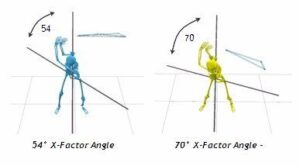The X-Factor
The term X-factor is used to describe the rotation of the shoulders in relation to the hip. Recent research (Myers 2008, Gordon 2009, Cheetham 2011 and Meister 2011) has found that there is a significant correlation between upper torso and pelvic separation and club head speed. In other words, the ability to rotate the upper trunk whilst keeping the pelvis still and vice versa. This separation utilises the muscle stretch shortening shortening cycle (SSC). The SSC explains the rapid change from an eccentric muscle contraction (when a muscle is lengthening) to a concentric contraction (when a muscle is shortening). This is a powerful tool inherent to all our muscles and is the reason why you can jump higher with a bit of a run up compared to just standing on the spot and jumping.
How to apply the SSC to the golf swing
To utilise the natural SSC, the trunk muscles that produce rotation need to be on stretch at the top of the swing. The muscles we are talking about are the obliques, and some of the erector spinae muscle group that run up either side of your spine. To place the muscles on stretch, the upper trunk/thoracic spine needs to move independently of the pelvis.
But BEWARE… Your rotation should be produced predominantly from your thoracic spine , NOT your lumbar spine. There is only 5-20degrees of available rotation in the lumbar spine but 60-80 degrees in the thoracic spine. Low back pain in golfers has been linked to a lack of thoracic rotation which results in the body trying to gain rotation out of the lumbar spine.
Test your X-factor
Try this simple drill. Stand in your golf stance, with hands across your chest. Keep you hips pointing straight ahead and try to rotate your shoulders/upper body to the right whilst maintaining your hip and pelvis position. You should almost be able to look over your left shoulder.
2 Simple exercises to improve your thoracic rotation and X-factor. (Video below)
Exercise 1 – Side lying thoracic rotation “Book Opener”
For a right-hander, lie on your left side with hips flexed to 90 degrees, knees together and arms outstretched. Keep your knees together, pelvis still and rotate your top arm up and over as far as you can. Aim to get your right shoulder blade on the floor. Perform 2 sets of 15 every day AND as part of your warm up.
Exercise 2 – Standing banded (resisted) rotation
For a right-hander, stand in your swing stance with the band attached at chest level to your left. Grip with both hands, keep arms straight and rotate trunk around to right, keeping hips and pelvis pointing straight ahead. Perform 3 sets of 10 once/day. As you improve you can step out further to increase resistance and also try standing on a 45 degree angle towards the band i.e. feet and hips pointing to the left 45 degrees.
There are a number of exercises that can be prescribed to address a lack of thoracic rotation including both mobility and strength exercises. if you would like to know more about how you can test and train the musculoskeletal system to get more out of your golf swing then please do not hesitate to contact us at our St Ives clinic at clinicalphysiostives.com.au




